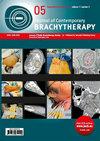Fletcher suit or ring: A comparison of Fletcher suit and ring applicators for retroverted uteri
IF 1.1
4区 医学
Q4 ONCOLOGY
引用次数: 0
Abstract
Purpose:Approximately 20% of women worldwide have a retroverted uterus. A retroverted uterus is closer to the rectum and may cause toxicity during brachytherapy. Upon manipulation, a small percentage turn anteverted. Conventional brachytherapy applicators are designed for an anteverted uterus and can pose issues during insertion. Modified Fletcher suit and ring applicators have major differences in their geometry to achieve similar target coverage, and were analyzed in this study with respect to immediate adverse events and dosimetry.
Material and methods:
Three hundred seventy-four consecutive applications performed over a 20-month period were studied retrospectively to identify intra-cavitary applications (ICAs) in retroverted uteri. Cases were divided into 2 groups: modified Fletcher suit applicator with hemi-ovoids (group A) and ring applicator (group B). D2cc for bladder and rectum were noted, and acute adverse events were recorded.
Results:
Seventy-five applications were identified, out of which 47 cases used Fletcher suit applicator, and 28 cases used ring applicator. The median bladder D2cc for group A and B were 5.98 Gy and 6.3 Gy, respectively, and the median rectum D2cc was 5.27 Gy and 3.68 Gy, respectively; the median dose prescribed to point A was 6 Gy (range, 5.5-9.0 Gy). All patients had a point A coverage between 97% and 102%. Eighteen cases in both groups complained of pain requiring analgesics. Twenty-five cases (53.2%) and 20 cases (71.4%) in group A and B, respectively, required dose optimization, which was statistically insignificant (p > 0.11). A significant difference was identified (p < 0.00001) in rectal doses. A higher reported pain was noted in ring applicator group (p < 0.03). No patient experienced a profuse bleeding.
Conclusions:
In most parameters, the two applicators demonstrated comparable results. The control of rectal dosage is superior in the ring applicator at the cost of higher pain incidence. Patient’s comfort and rectal dose in EBRT should be taken into consideration, with preference given to the ring applicator.
弗莱彻套或环弗莱彻套式和上环器治疗子宫后倾的比较
目的:全世界约有 20% 的女性子宫后倾。后倾的子宫更靠近直肠,可能会在近距离放射治疗过程中产生毒性。在操作过程中,有一小部分会变成前倾。传统近距离放射治疗器是为前倾子宫设计的,在插入时可能会造成问题。材料和方法:我们对 20 个月内连续进行的 374 例应用进行了回顾性研究,以确定后倾子宫腔内应用(ICA)的情况。病例分为两组:改良弗莱彻套式半绒毛涂抹器(A 组)和环形涂抹器(B 组)。结果:共发现 75 例应用,其中 47 例使用 Fletcher 套式涂药器,28 例使用环形涂药器。A 组和 B 组的膀胱 D2cc 中位数分别为 5.98 Gy 和 6.3 Gy,直肠 D2cc 中位数分别为 5.27 Gy 和 3.68 Gy;A 点的中位剂量为 6 Gy(范围为 5.5-9.0 Gy)。所有患者的 A 点覆盖率都在 97% 到 102% 之间。两组中均有 18 例患者主诉疼痛,需要使用镇痛剂。A 组和 B 组分别有 25 例(53.2%)和 20 例(71.4%)患者需要优化剂量,这在统计学上并不显著(p > 0.11)。直肠剂量差异明显(p< 0.00001)。环形涂抹组的疼痛报告较高(p < 0.03)。结论:在大多数参数上,两种涂药器的效果相当。结论:在大多数参数上,两种涂药器的效果相当。环形涂药器对直肠剂量的控制更好,但疼痛发生率更高。在进行 EBRT 时,应考虑患者的舒适度和直肠剂量,优先选择环形涂抹器。
本文章由计算机程序翻译,如有差异,请以英文原文为准。
求助全文
约1分钟内获得全文
求助全文
来源期刊

Journal of Contemporary Brachytherapy
ONCOLOGY-RADIOLOGY, NUCLEAR MEDICINE & MEDICAL IMAGING
CiteScore
2.40
自引率
14.30%
发文量
54
审稿时长
16 weeks
期刊介绍:
The “Journal of Contemporary Brachytherapy” is an international and multidisciplinary journal that will publish papers of original research as well as reviews of articles. Main subjects of the journal include: clinical brachytherapy, combined modality treatment, advances in radiobiology, hyperthermia and tumour biology, as well as physical aspects relevant to brachytherapy, particularly in the field of imaging, dosimetry and radiation therapy planning. Original contributions will include experimental studies of combined modality treatment, tumor sensitization and normal tissue protection, molecular radiation biology, and clinical investigations of cancer treatment in brachytherapy. Another field of interest will be the educational part of the journal.
 求助内容:
求助内容: 应助结果提醒方式:
应助结果提醒方式:


